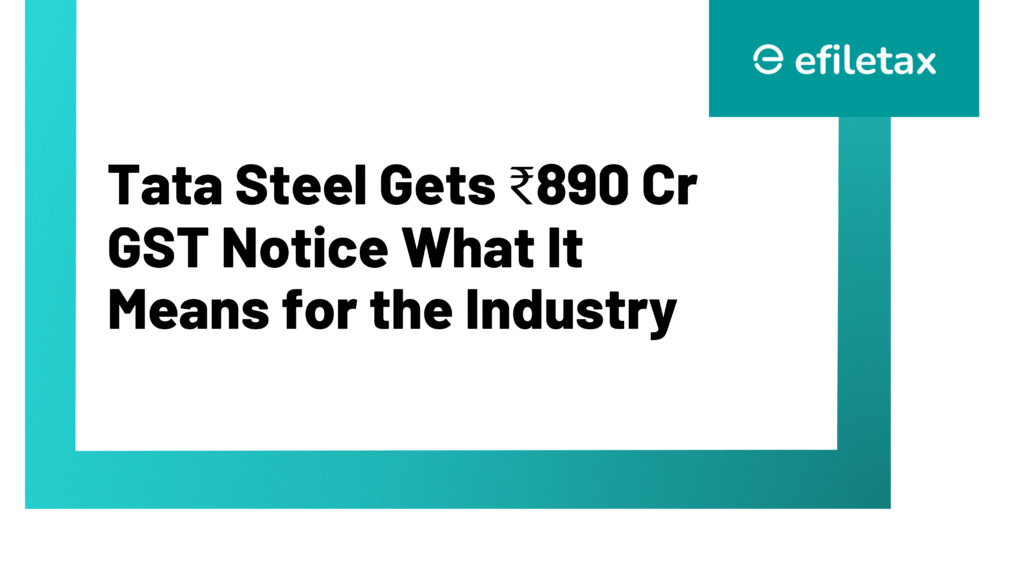
Tata Steel gets ₹890 crore GST notice Key insights for Indian taxpayers
In a recent development, Tata Steel has received a GST demand notice of ₹890 crore, which includes tax, interest, and penalty. This case highlights how large GST liabilities can arise even for well-established companies—and offers lessons for every Indian business on compliance, audit risks, and legal remedies.
Let’s break it down in simple terms.
What is the ₹890 crore GST notice about?
It pertains to an alleged wrongful claim of input tax credit (ITC) and related tax liabilities under the Central Goods and Services Tax Act, 2017.
Here’s what’s included in the ₹890 crore:
- Tax amount: ₹486.34 crore
- Interest: ₹273.74 crore
- Penalty: ₹130.79 crore
- Total: ₹890.87 crore
📌 Source: BSE Corporate Filing, 26 June 2025
Legal basis: When can GST officers issue such notices?
The notice appears to have been issued under Section 74 of the CGST Act, 2017, which deals with:
“Tax not paid or short paid or erroneously refunded or input tax credit wrongly availed or utilised by reason of fraud or any wilful misstatement or suppression of facts.”
Under Section 74:
- The taxpayer has the right to reply
- Adjudication follows, with appeal options under GST law
Legal Reference: CGST Act, 2017 – Section 74
Tata Steel’s response to the GST notice
Tata Steel clarified that:
- The notice is a pre-adjudication show cause notice
- The company intends to respond and contest it appropriately
This is a standard process where the department raises a demand, and the taxpayer gets an opportunity to explain or contest the claim.
What Indian businesses can learn from this case
This case is a wake-up call for all businesses—big or small. Here’s why:
Ensure proper Input Tax Credit (ITC) claims
- Match ITC with GSTR-2B every month
- Reconcile with vendor filings
- Avoid claiming credit if invoices are not GST-compliant
Maintain robust documentation
- Keep records of tax invoices, purchase orders, delivery notes
- Be ready for audit, especially for FY 2017–2021, which are still under scrutiny
Be prepared for departmental audits
- Many notices are issued post-GST audit or investigation
- Have a standard operating procedure (SOP) for handling queries
Respond promptly to show cause notices
- Ignoring notices can escalate to penalty and recovery
- Always reply within the stipulated time
Expert view: Why ITC compliance matters more now
“The GST audit cycle is catching up. Most states are now issuing notices for FY 2018–19 and FY 2019–20. If your books aren’t reconciled with GSTR-2B or GSTR-1/3B, expect scrutiny,”
says a senior GST consultant at Efiletax.
Quick comparison: Section 73 vs Section 74 of CGST Act
| Feature | Section 73 | Section 74 |
|---|---|---|
| Applicable when | No fraud or suppression involved | Fraud, willful misstatement, or suppression involved |
| Penalty | Nil (if paid before SCN) | 15% to 100% depending on stage |
| Time limit for SCN | 2 years, 9 months from FY end | 5 years from FY end |
| Benefit of voluntary payment | Yes | Yes (limited) |
Summary
Tata Steel has received a ₹890 crore GST notice for alleged wrong ITC claims. Issued under Section 74 of CGST Act, this case highlights growing scrutiny by GST authorities. Businesses must reconcile ITC, respond to SCNs, and maintain strong compliance records.
FAQs on GST notices like Tata Steel case
What is a GST show cause notice?
A show cause notice (SCN) is a legal intimation from the GST department asking the taxpayer to explain discrepancies, usually before imposing tax, interest, or penalty.
Can you contest a GST notice?
Yes. You can file a reply, attend hearings, and appeal if unsatisfied with the order. Filing on time is crucial.
What is the penalty under Section 74?
Penalty can go up to 100% of the tax amount if fraud or suppression is proven.
Final thoughts: GST notices are serious – act early
The ₹890 crore demand on Tata Steel is a reminder that GST compliance is no longer just a paperwork task—it’s a legal responsibility. With audits increasing and older years under review, Indian businesses must review ITC claims, correct mismatches, and respond to notices proactively.